1990 - Employee awards program is instituted to recognize outstanding service.
1991 - Information Services Division is created as the fourth division within the OSBI. Its purpose is to handle the increased demand for information by law enforcement and the public.
1991 - Construction begins on a new Eastern Regional Laboratory and Investigative Office in McAlester.
1991 - The Special Investigations Unit is created to investigate public corruption, government fraud, and other white-collar cases.
1991 - Senate Bill 386 authorizes the establishment of a DNA analysis unit with the OSBI Central Laboratory.
1992 - 8,000 square feet is renovated at OSBI Headquarters to make way for the new Automated Fingerprint Identification System (AFIS).
1992 - Construction begins on a new Southwest Regional Laboratory and Investigative Office in Lawton.
1993 - The Criminal Information Unit expands its role to become the state clearinghouse for information on missing children.
1993 - The Special Investigations Unit completes its 14-month probe into the 1990 campaign contributions of Governor David Walters. Unlike the previous investigation of then Governor Hall, the Walters investigation proceeds without any OSBI employees losing their jobs. The OSBI Commission's purpose as an insulator to the bureau from political influence and pressure is solidified.
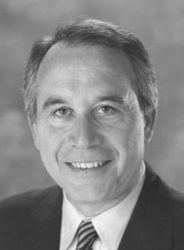 1994 - OSBI Agents are equipped with laptop computers to aid in report writing, case management, and other investigative functions.
1994 - OSBI Agents are equipped with laptop computers to aid in report writing, case management, and other investigative functions.
1994 - In May, installation is completed on the OSBI's multimillion-dollar Automated Fingerprint Identification Unit. This technological advancement provides the OSBI with a faster response time in identifying latent fingerprints found at crimes where unidentified prints are found. The system was formally dedicated in the memory of Tracey Neilson, who was stabbed to death in her Moore apartment on her 21st birthday in 1981. Her killer has never been found.
Before the acquisition of the AFIS system, the OSBI could only search for a latent match if the suspect's name was known. Now, all local law enforcement need to provide is a latent print or partial print, and the OSBI can search its entire database of 4.5 million fingerprints within minutes. Although a latent fingerprint expert is still needed to make the actual match, the AFIS system can narrow down the search to as few as ten possible suspects.
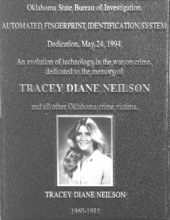 1994 - The OSBI Central Laboratory begins accepting cases in its DNA Profiling Section.
1994 - The OSBI Central Laboratory begins accepting cases in its DNA Profiling Section.
1995 - Passage of the Oklahoma Self-Defense Act authorizes the OSBI to license eligible Oklahomans who wish to carry a concealed weapon. During the first year, more than 13,000 applications are processed by the bureau.
1995 - April 19th, twenty minutes after a bomb ripped through the heart of downtown Oklahoma City, and hours before anyone knew exactly what had happened, OSBI Director A. DeWade Langley sends out a request for all available OSBI agents to respond to the scene at the Alfred P. Murrah Building. Forty agents from across the state respond.
That evening, agents man phones at the Mayor's office, taking calls and leads from anyone who had been inside the building or near it at the time of the blast. The goals are to find out if anyone saw or heard anything unusual before the bomb exploded and to account for those people who were or were not in the building when the bomb exploded. These same agents field numerous leads until the Federal Bureau of Investigation is able to set up a command post. This assignment lasts more than three weeks.
OSBI Laboratory employees are also called out to aid in the collection of crime scene evidence and to take crime scene photos. Criminalists keep the Central Lab open late to allow Alcohol, Tobacco and Firearms' agents to examine the collected evidence.
OSBI Latent Fingerprint Technicians had the difficult task of identifying many of the children who died in the bombing. While most adult bombing victims were identified by dental records, many of the children were not old enough to have such records. They had to be identified by fingerprints. Bureau employees had to go to the home of these children to dust toys and other belongings. This method helped identify 12 of the 19 children who died in the blast.
Seventy-three OSBI employees worked directly on the bombing case. This agency is proud of their professionalism and their dedication to furthering the agency's mission, especially in such a difficult case.
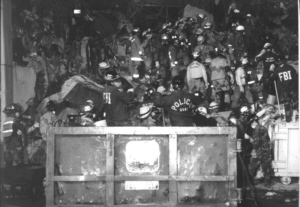 1995 - Three-year-old Ryan Aubrey Luke dies, and OSBI Agents investigate the murder. The crime and subsequent public outcry spawn the "Ryan Luke Bill" to protect Oklahoma children.
1995 - Three-year-old Ryan Aubrey Luke dies, and OSBI Agents investigate the murder. The crime and subsequent public outcry spawn the "Ryan Luke Bill" to protect Oklahoma children.
1996 - The Criminal Intelligence Unit is statutorily created and is authorized to collect, analyze, and disseminate intelligence information to law enforcement for use of criminal investigations and crime prevention.
1996 - The OSBI Central Laboratory is authorized to begin collecting the DNA profiles of all persons convicted of certain violent crimes in the state.
1997 - The Firearms and Toolmarks Unit of the OSBI Laboratory installs a new electronic database and image capture system. "Drugfire" is designed to allow firearms examiners to enter, store, search, retrieve, and share information from fired casings and bullets.
1998 - "The Shadow," a new tracking device, is unveiled by the Investigative Services Division. The new tool can be used to track a targeted suspect vehicle within 75 yards of its exact location.
1999 - A new DNA profiling technique called PCR-STR is being used in the Criminalistic Services Division. The new technique is automated and not as labor intensive. It can run tests on biological samples in half an hour or less.
1998 - The OSBI joins the Metro Fugitive Apprehension Task Force which is designed to track and arrest fugitives in the Oklahoma City metro and around the state.
1999 - Construction is completed on the Northeastern Regional Laboratory and Investigative Offices in Tahlequah.
1999 - The OSBI goes online with its website offering agency information, job postings, and forms for Criminal History Records requests and the Oklahoma Self-Defense Act.
1999 - Two Agents complete training in computer forensics.
1999 - Work begins on a multimillion-dollar computer upgrade of AFIS.
1999 - Eastern Oklahoma is outraged when an 80-year-old wheelchair bound man and his 75-year-old wife are murdered in their rural McIntosh County home. Three OSBI agents, two OSBI serologists, and two OSBI fingerprint experts investigate the case. The suspects are charged within three days.
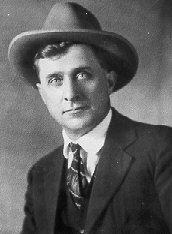


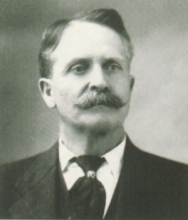
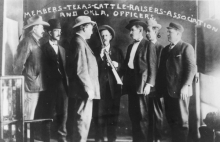
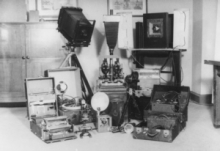
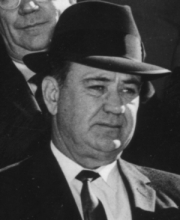
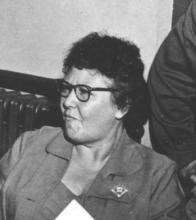
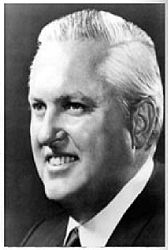 1977
1977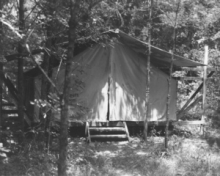
 1994
1994 1994
1994 1995
1995